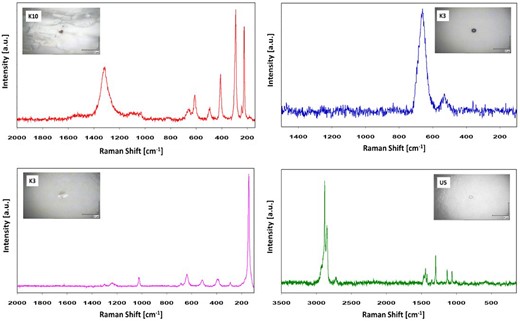-
PDF
- Split View
-
Views
-
Cite
Cite
Ottavia Exacoustos, Cristina Artini, Sara Massardo, Claudia Caboni, Andrea Pastorino, Silvio Chiarenza, Gianluigi Zaza, Giovanni Stallone, Gian Marco Ghiggeri, Andrea Angeletti, Francesca Lugani, Enrico Eugenio Verrina, Edoardo La Porta, Pasquale Esposito, Francesca Viazzi, Daniela Verzola, Chiara Paccagnella, Stefano Alberti, #6111 FIRST IDENTIFICATION AND CHARACTERIZATION OF MICROPLASTICS IN HUMAN KIDNEY AND URINE, Nephrology Dialysis Transplantation, Volume 38, Issue Supplement_1, June 2023, gfad063a_6111, https://doi.org/10.1093/ndt/gfad063a_6111
Close - Share Icon Share
Abstract
Microplastics (MPs), plastic fragments less than 5mm in diameter, have been recognized as a global environmental issue. Various studies have shown their ubiquitous presence and their toxicity on marine and terrestrial fauna. Currently in humans, the presence of MP has been evidenced in lungs, placenta, blood, and liver. However, there is still very little knowledge about their presence in different organs and tissues and their prospective toxicity. The objective of this study was to investigate the presence of microplastics in human kidneys and urine.
We obtained 10 urine samples from healthy individuals and 10 kidney healthy tissue samples from nephrectomies in renal cancer The detection and characterization of microplastics was performed by a light microscope (Leica, total magnification of 500x) coupled to a Raman spectrometer (Renishaw System 2000). To this purpose, specimens were digested by a 10% KOH solution at 60°C and subsequently filtered on membrane filters with micropores of 0.2 μm to retain possible particles. This procedure was performed adopting a “plastic-free” protocol. Procedural blanks were performed as controls using the same protocol. To determine the nature of the detected particles, Raman spectra were compared to the ones present in the Renishaw spectrometer database (inorganic materials, polymers and forensic materials) [i], in the SLOPP Library of Microplastics [ii], and in the IRUG Spectral Database (pigments section) [iii]. A home-developed software was employed to compare spectra. Data analysis was performed by using the statistical software package Prism6 (Graphpad Software) Chi-square test, Student's t-test were performed to compare data accordingly. The significance threshold was set at p < 0.05.
17 fragments (mean 1,7±2,11/sample) were identified and characterized on 7 out of 10 human kidney samples. The result was significant (p.value 0.041) compared with controls (mean 0,33±0,49/blank). 9 fragments were identified and characterized on 7 out of 10 human urine sample (mean 1.28±0,49/sample) highly significant (p.value 0.0002). Spectra analyzed by microRaman showed the presence polymers, polymers additives and pigments associated to polymers such as: hematite, Cu- phthalocyanine blue, Cerulean Blue, Polystyrene, Styrene-Isoprene and polyethylene.
We first demonstrated the presence of MPs in human kidneys, and we also confirm their presence in urine assuming the presence of a kidney clearance mechanism. Using Raman Microspectroscopy, it was also possible to determine the nature and quantity of MPs. The remarkable relevance of this identification, potentially concern much of the humans, deserve a widespread attention of the medical community for its potential implications. Further studies are urgently needed to investigate the possible nephrotoxicity of MPs, mechanisms of kidney clearance and tissue accumulation.

Raman spectra collected on the microplastics most commonly occurring in the analyzed samples.
Synoptic view of the microplastics particles detected by μ-Raman spectroscopy.
| . | . | Particle Material i,ii,iii . | |||||
|---|---|---|---|---|---|---|---|
| Sample, Total n . | Positive sample for particles; total particles . | Cu- phthalocyanine blue . | Hematite . | Cerulean blue . | Polyethylene . | Polystyrene . | Other . |
| Urine, n 10 | 7;9 | 1 | 4 | - | 1 | 2 | 1 |
| Kidney, n 10 | 7;17 | 3 | 6 | 1 | 1 | 1 | 1 |
| . | . | Particle Material i,ii,iii . | |||||
|---|---|---|---|---|---|---|---|
| Sample, Total n . | Positive sample for particles; total particles . | Cu- phthalocyanine blue . | Hematite . | Cerulean blue . | Polyethylene . | Polystyrene . | Other . |
| Urine, n 10 | 7;9 | 1 | 4 | - | 1 | 2 | 1 |
| Kidney, n 10 | 7;17 | 3 | 6 | 1 | 1 | 1 | 1 |
Synoptic view of the microplastics particles detected by μ-Raman spectroscopy.
| . | . | Particle Material i,ii,iii . | |||||
|---|---|---|---|---|---|---|---|
| Sample, Total n . | Positive sample for particles; total particles . | Cu- phthalocyanine blue . | Hematite . | Cerulean blue . | Polyethylene . | Polystyrene . | Other . |
| Urine, n 10 | 7;9 | 1 | 4 | - | 1 | 2 | 1 |
| Kidney, n 10 | 7;17 | 3 | 6 | 1 | 1 | 1 | 1 |
| . | . | Particle Material i,ii,iii . | |||||
|---|---|---|---|---|---|---|---|
| Sample, Total n . | Positive sample for particles; total particles . | Cu- phthalocyanine blue . | Hematite . | Cerulean blue . | Polyethylene . | Polystyrene . | Other . |
| Urine, n 10 | 7;9 | 1 | 4 | - | 1 | 2 | 1 |
| Kidney, n 10 | 7;17 | 3 | 6 | 1 | 1 | 1 | 1 |
Footnotes
Renishaw plc Spectroscopy Products Division, Old Town, Wotton-Under-Edge, Gloucestershire, GL12 7DH.
SLOPP Library of Microplastics [WWW Document], n.d. URL https://rochmanlab.com/s lopp-and-slopp-e-raman-spectral-libraries-for-microplastics-research.
Price B. A., Pretzel B., Quillen Lomax S. eds. Infrared and Raman Users Group Spectral Database. 2007 ed. Vol. 1 & 2. Philadelphia: IRUG, 2009. Infrared and Raman Users Group Spectral Database. Web. 20 June 2014, www.irug.org.
- lung
- drug clearance
- identification (psychology)
- libraries
- mucopolysaccharidoses
- nephrectomy
- pigment
- polymers
- polystyrenes
- software
- spectrum analysis
- styrene
- kidney
- liver
- placenta
- polyethylene
- urine
- potassium hydroxide
- magnification
- toxic effect
- nephrotoxicity
- membrane filtration
- microscopes, light
- community
- massively-parallel genome sequencing
- tissue specimen
- renal cancer
- urine specimens
- data analysis
- microplastics





Comments